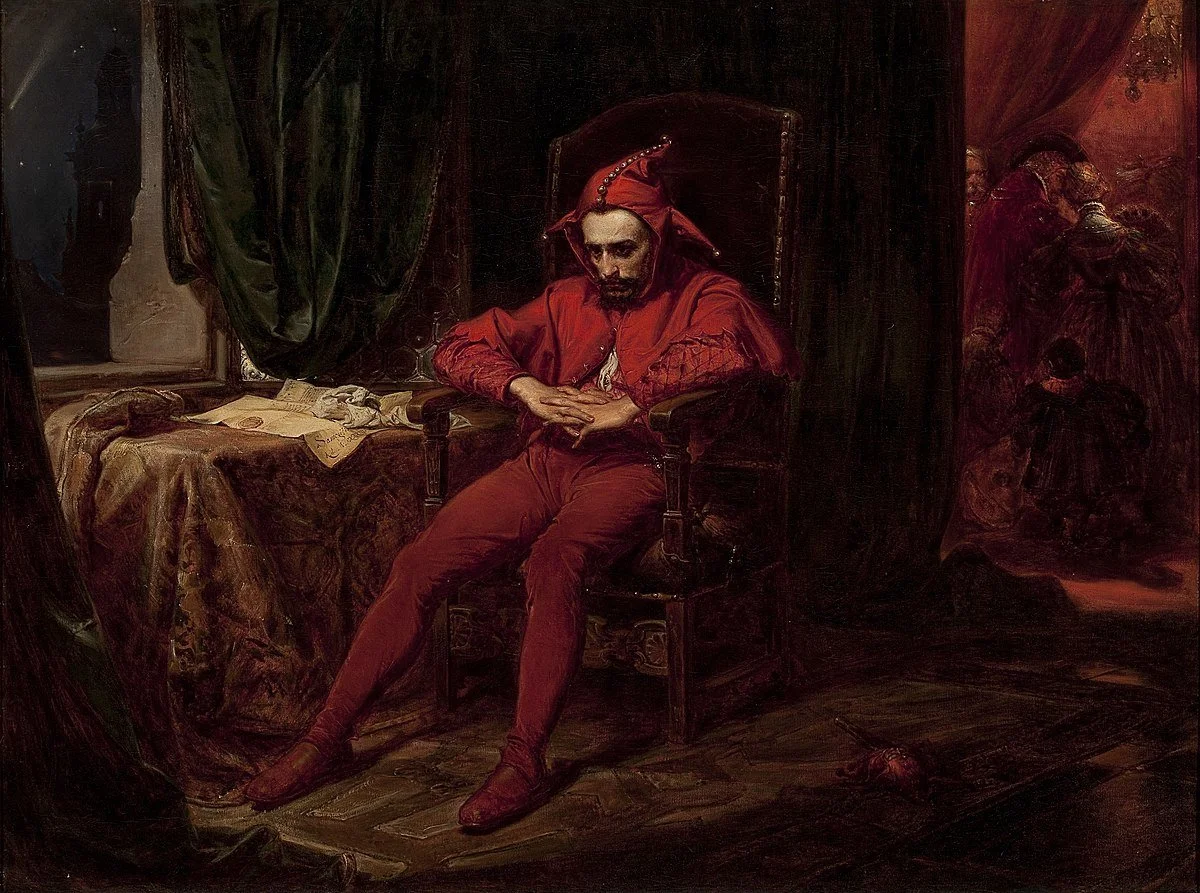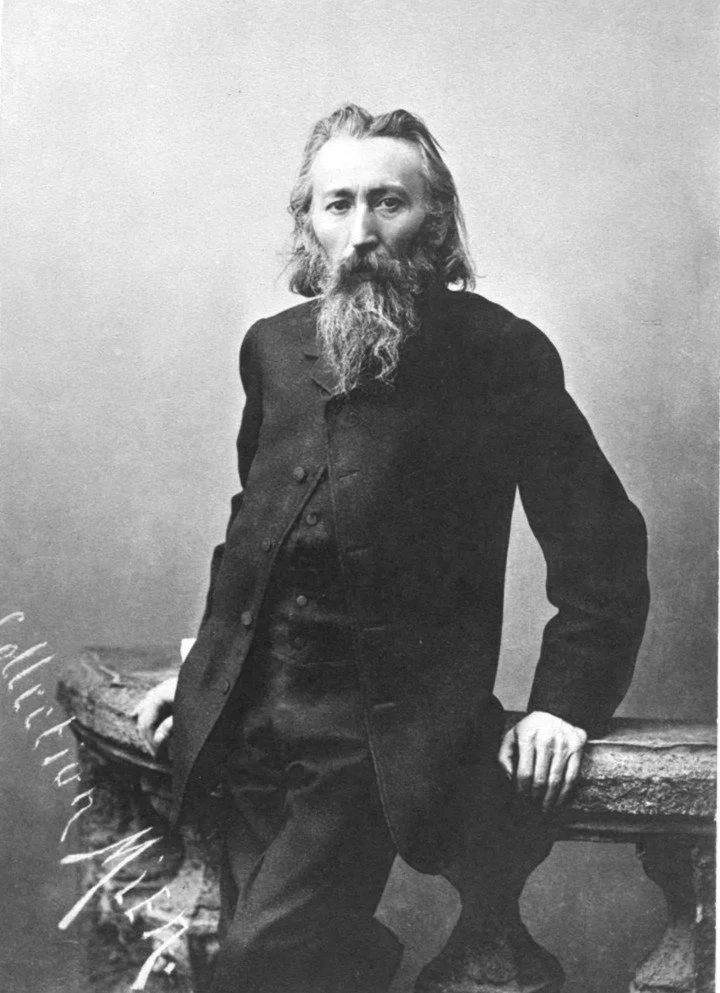Behind the Painting: Unveiling the Layers of Meaning in Stańczyk
Welcome to my blog series, “Behind the Painting”, where I dive into the realm of art and analyze the stories and symbolism hidden within works of art. In this first edition I unravel the painting, ‘Stanczyk’ (excuse the lack of accent on the ‘n’, it wants to appear weird - as seen here: Stańczyk.) , by Jan Matejko. Join me as I begin to unravel the layers of meaning within this melancholic work of art, shedding light on its historical context, artistic choices, and significance.
Jan Matejko. Stanczyk. 1862. Oil on Canvas. 120 cm × 88 cm. Warsaw National Museum, Warsaw.
The Painting:
Stanczyk is a renowned painting by Polish artist Jan Matejko, created during the 19th century. This painting is currently housed in the Warsaw National Museum. Whilst known by many as just ‘Stanczyk’, the full title of this piece is ‘Stanczyk during a ball at the court of Queen Bona in the face of the loss of Smolensk’ At first glance, it depicts a court jester (Stanczyk) with his head bowed lost in thought, gazing out into the distance with a mixture of contemplation and melancholy - an appearance juxtaposing what one would expect of a jester. Papers sit to his right on a desk, opened and assumably read whilst a party happen outside the chamber.
However, beneath the surface, lies a rich tapestry of symbolism and historical significance that adds depth and complexity to the painting.
The Artist:
Jan Matejko, a prominent Polish painter, earned renown for his historical and patriotic masterpieces, which vividly portrayed scenes from Polish history. His artistic style was characterized by a remarkable attention to detail, realism, and a meticulous representation of clothing, architecture, and customs from the respective periods he depicted.
Beyond technical precision, Matejko possessed a unique talent for infusing his compositions with powerful emotions and dramatic intensity, captivating viewers with compelling narratives. Through his art, he masterfully commemorated and celebrated Poland's rich history and cultural heritage, instilling a sense of pride and identity in his audiences.
In "Stanczyk," Matejko diverged from his customary dynamic compositions and chose a more tranquil setting. Focusing on a solitary subject, he skillfully captured the essence of contemplation and introspection. Despite its calm demeanor, "Stanczyk" remains a testament to Matejko's ability to convey profound emotions through paint and offers a striking contrast to his other vibrant historical portrayals.
Stanczyk:
Stanczyk, a famous court jester during the Polish Renaissance under the reign of King Sigismund I the Old, etched a lasting legacy with his sharp wit and intellect, especially concerning political and national affairs.
His mastery of satire allowed him to cleverly expose court hypocrisies in a manner that captured the attention of those in power. As a fervent patriot, Stanczyk keenly recognized the profound implications of the loss of Smolensk for the future of his beloved land. Using political issues as comedic fodder, he skillfully delivered essential messages that resonated with both kings and commoners alike.
Over time, Stanczyk has evolved into a revered cultural symbol of Poland, permeating various forms of art and literature. Jan Matejko, in particular, immortalized the jester in several of his masterful paintings, such as "The Hanging of the Sigismund Bell," "Prussian Homage," and "Gamrat," ensuring that Stanczyk's indomitable spirit endures through the ages.
There is no certainty around the jesters true name, with some historians supposing it to be “Stanislaw Gaska”.
Historical Context:
To grasp the true essence of the painting, we must delve into the historical context that shaped its creation. 'Stanczyk' emerged during a period of political unrest and foreign dominance in Poland. Jan Matejko, known for his strong nationalist sentiments, utilized his art as a powerful vehicle to convey the collective consciousness and resistance of the Polish people. What was once perceived as a simple depiction of a jester, 'Stanczyk' transformed into an emblem of national resilience and defiance against oppression.
The painting serves as a poignant representation of 19th-century Polish society, capturing the profound impact of the loss of Smolensk, a fortress that held vital significance as a stronghold against the Grand Duchy of Moscow. Its fall foreshadowed a series of tragic events that would befall Poland in the ensuing decades.
Within the artwork, the figures at the ball symbolize the Polish nobles who, in pursuit of self-interest and personal gain, compromised the nation's sovereignty by aligning themselves with foreign empires. This opportunistic course of action ultimately contributed to the downfall of the nation.
Through 'Stanczyk,' Jan Matejko masterfully depicts the palpable tension between resilience and vulnerability, reflecting the turbulent times and the enduring spirit of the Polish people in the face of adversity. The painting serves as a profound testament to the artist's skill in intertwining historical events with powerful visual narratives, leaving a lasting impact on the viewers and reinforcing the importance of art as a means of preserving and interpreting collective memory.
Symbolism and Meaning:
Within this painting lies many symbols - objects painted with intent that could provide greater meaning and context to the painting and the artist.
Marotte - A prop often used by jesters, is seen discarded on the floor. This object is a vehicle for the authenticity of the jester’s emotions in that moment.
Black Madonna - A holy medallion of the Black Madonna is seen on Stanczyk’s torso. A symbol of hope an an important icon for Polish Christians.
Wawel Cathedral - Visible on the left side of the painting, painted against a dark gloomy night sky. This cathedral is where the kings would’ve been coronates.
Dwarf with a Lute - A court dwarf, stereotyped as a person of low stature and morale during this time period, is seen in the background with the party-goers, carrying a lute, a symbol of glory.
Comet - Visible to the left of the Wawel Cathedral, a sign of misfortune. Matejko was known for his use of astronomy symbolically in his paintings.
Orion’s Belt - Painted above the Wawel Cathedral. In Greek mythology, Orion was a hunter blinded by his ego who met his fate at the sting of a scorpion. A metaphor being related to the painting.
Letter on Table - On the table beside Stanczyk is a discarded letter with the year 1533 (A.D MDXXXIII) and “Samogitia”, a province of the Commonwealth. What the note details is of ongoing debate with it likely being about the fall of Smolensk.
Stanczyk’s Face - The features of which match Matejko’s in an allusion to Metejko’s own emotions on the situation.
Artistic Execution:
This painting delves into a level of intimacy not commonly seen in Jan Matejko's works, as it immerses the viewer in a moment shared solely between them and Stanczyk. The scene evokes a sense of serendipity, as if a letter had been carelessly left behind by an elite, and Stanczyk unexpectedly stumbled upon its unfortunate contents.
As the jester reads the distressing message, a wave of emotions overcomes him, and he collapses into a nearby chair, allowing his limbs to go limp. In the midst of his turmoil, the Marotte slips from his grasp and falls to the ground. The subtle crease on the carpet, seemingly caused by Stanczyk's instinctive recoil after sitting down, adds to the authenticity of the moment.
Stanczyk's striking crimson suit seems to blend into the surrounding dark red hues, hinting that he finds himself in the opulent abode of a wealthy individual, specifically the court of Queen Bona. However, his demeanor no longer reflects the festive atmosphere of the ball taking place there.
Both physically and mentally, Stanczyk finds himself caught between two contrasting worlds. His external state mirrors the tranquility of the night sky, while his inner turmoil echoes the lively chatter of the ballroom. Through the window, the Wawel Cathedral is visible, yet its historical accuracy remains uncertain, lending an air of intrigue to the scene.
The stark contrast between Stanczyk and the black wall framing him draws immediate attention, enhancing the emotional depth of the piece. Employing predominantly dark tones of black and grey, with hints of blue and green near the window, the painting conveys a somber atmosphere. Interestingly, the presence of red hues in both the party and Stanczyk's clothing suggests a potential connection between the two, perhaps implying a unity that has been disrupted by the contents of the letter.
In this intimate portrayal, Jan Matejko skillfully weaves together various elements to evoke powerful emotions and stimulate the viewer's imagination, inviting them to immerse themselves in the enigmatic world of Stanczyk's inner turmoil.
Conclusion:
Through his art, Matejko commemorated the rich history and cultural heritage of Poland, instilling a sense of pride and identity in the hearts of his audiences. The artist's profound understanding of human emotion and ability to infuse his compositions with powerful narratives cemented his position as a prominent figure in Polish art history.
As we unraveled the layers of meaning within 'Stanczyk,' we are reminded of the enduring power of art to transcend time and speak to the human spirit across generations. The painting serves as a testament to the importance of exploring and preserving our historical narratives through the lens of art, shedding light on the complex stories that shaped the course of nations.
In this first edition of "Behind the Painting," we uncovered some more details in Matejko's masterpiece, yet there is still more to uncover. As we continue our journey through the realm of art, we will unveil more hidden narratives, symbols, and meanings, opening our minds to the profound impact that art has on our understanding of the world and ourselves. Together, we will discover the timeless power of art to provoke thought, evoke emotion, and connect us to our shared human experience.
I hope you enjoyed reading! If there is a specific piece of art you’d like me to attempt to analyze then please do comment it down below. Alternatively, if you have spotted some more hidden meanings to this painting that I have yet to cover then feel free to share it below!
Until next time,
Rhiannon x


